The Meaning of Mecca, Islam’s Holiest City
Mecca (also spelled as Makkah) is regarded as the holiest city in Islam. Apart from the fact that Mecca was the birthplace of the Prophet Muhammad, it is also the city where Islam’s holiest place of worship, the Great Mosque (more commonly known as al-Masjid al-Haram) is located. In addition, it is in the direction of Mecca that Muslims face when they perform their daily prayers. Furthermore, one of the Five Pillars of Islam, the Hajj, or Pilgrimage, involves an extended visit to the city.
Where is Mecca?
Mecca is located in the western part of the Arabian Peninsula, in what is today the Makkah region of Saudi Arabia. The sacred city is historically part of the Hejaz, which stretches along the Arabian Peninsula’s Red Sea coast from Jordan in the north to the Asir region in the south. Mecca is situated 73 km (45 mi.) inland from Jeddah, the commercial hub of Saudi Arabia.
The city sits in the Wadi Ibrahim (Valley of Abraham), and is surrounded by the Sirat Mountains. There are four passes through the mountains that grant access to the holy city.
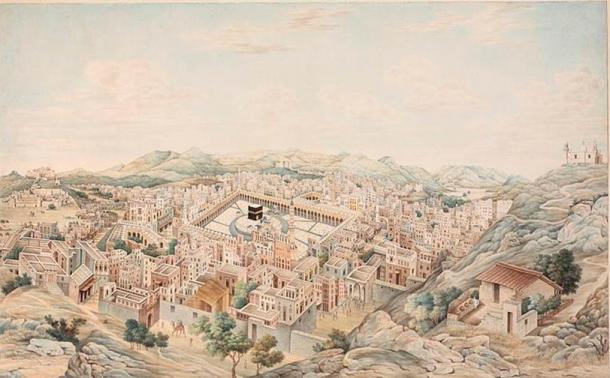
Panoramic View of Mecca, Mecca, Saudi Arabia, 1845. From the Nasser D. Khalili Collection of Hajj and the Arts of Pilgrimage. (Khalili Foundation/CC BY SA 4.0)
Mecca is most closely associated with the Islamic faith. Nevertheless, the city was already a significant religious center and key spot for trading even before the founding of Islam. This is due to the fact that Mecca was an oasis on the trade route that linked the Mediterranean world with Southern Arabia, East Africa, and the Indian subcontinent.
Due to Mecca’s strategic geographical location, it was developed during the Roman and Byzantine periods. It is possible that Mecca was also known to the peoples of the Hellenistic period. In Ptolemy’s Geography, a city in the interior of the Arabian Peninsula called Macoraba is mentioned. Macoraba has been traditionally identified with Mecca, though some modern scholars have cast doubts on this identification.
The Earliest History of Mecca
Still, ancient writings referring to Mecca seems to be scarce. Instead, the main source of information for this part of the city’s history comes from later Islamic and Arabic sources. Islamic tradition, for example, traces the history of Mecca all the way back to the beginning of time.
It is believed that when Adam and Eve were thrown out of Paradise, they were separated. Adam landed on the island of Sri Lanka, while Eve found herself in the area that is now Jeddah. After wandering the earth on their own for a period of time, Adam and Eve were reunited by God on Mount Arafat, to the east of Mecca. Arabic sources also state that Adam was buried in Mecca. Eve, on the other hand, was buried in nearby Jeddah.
The next appearance of Mecca in Islamic tradition is in the story of the Great Flood. It is said that during the flood, Noah’s ark came to Mecca, and passed around the disinterred body of Adam seven times. According to the Quran, Abraham and Ishmael (Abraham’s son by Hagar) were responsible for building (or rebuilding) the Kaaba in Mecca (more about the Ka’aba later in this article). The city is also associated with Abraham by the belief that it was there that Hagar nursed Ishmael back to health with the waters of the Well of Zamzam.
The Arabian Peninsula Before Islam
Muslims refer to the period on the Arabian Peninsula before the arrival of Islam as Jahiliyya, which may be translated to mean ‘Age of Ignorance’. The term Jahiliyya is normally used pejoratively to refer to the pre-Islamic period in the Arabian Peninsula. The Jahiliyya period is important for Muslims, as it is serves to highlight the change brought about by Islam to the Arab way of life.
Some features of the Jahiliyya period include: the worship of idols, tribalism, and the practice of female infanticide. In short, the Jahiliyya period was thought to have been a dark age. Interestingly, the term Jahiliyya is considered to be positive with regards to Arabic literature, as pre-Islamic Arabic poetry is esteemed by Muslims.
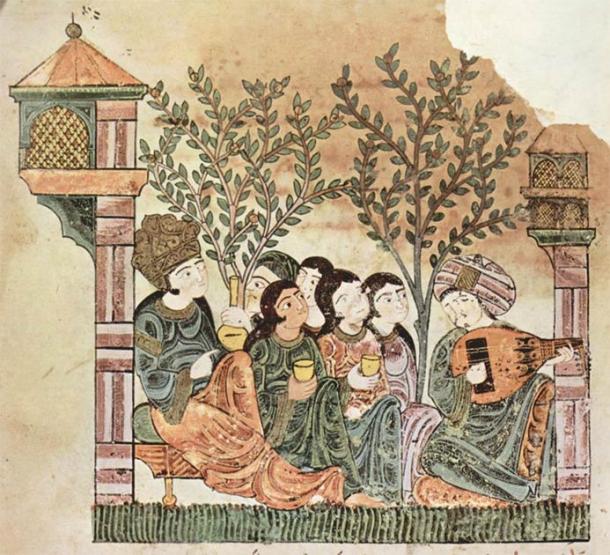
"Bayad plays the oud to the lady", Arabic manuscript for ‘Qissat Bayad wa Reyad’ tale (late 12th century). (Public Domain)
Mecca and the Birth of Islam
The birth of Islam is normally portrayed as a radical break from the Jahiliyya period. The story of Islam began in Mecca in 570 AD. According to tradition, this was the year that the Prophet Muhammad was born.
For the first 40 years of his life, Muhammad lived as an ordinary man. Muhammad’s father is said to have died before he was born, while his mother died when he was six years old. The future prophet was raised by his paternal grandfather until the latter’s death two years later.
Finally, he came into the care of his uncle, Abu Talib, who had become the new head of the Hashim clan. According to one story, while accompanying his uncle on a trading journey to Syria, Muhammad was recognized as a future prophet by a Christian monk. At the age of 25, Muhammad married a wealthy woman named Khadijah, who was 40 years old. Khadijah had employed Muhammad to oversee the transportation of her goods to Syria, and was so impressed by him, that she offered to marry him.
Every once in a while, Muhammad would seclude himself in a cave on one of the mountains near Mecca. One night in his fortieth year, as Muhammad was meditating in the cave, the angel Jibril (Gabriel) appeared to him, and gave him his first revelation. The angel taught him the opening verses of Surah 96 of the Quran: “Recite in the name of your Lord who creates, / creates man from a clot! / Recite for your Lord is most generous…”
The encounter with the angel left Muhammad feeling disturbed, but he was reassured by Khadijah and her cousin, Waraqah ibn Nawfal (a Christian who confirmed Muhammad’s prophethood). Muhammad continued receiving revelations from Jibril, but for the next three years, limited himself to speaking about them in private.

The angel Jibrîl stands before Muhammad and instructs him on the call to prayer. (Public Domain)
The Prophet Muhammad at Mecca
Eventually, Muhammad was commanded by God to preach publicly. Initially, the Meccans did not oppose Muhammad. When the prophet began proclaiming that there is no god but Allah, however, he began to face opposition from the Quraysh of Mecca.
This is due to the fact that the monotheism preached by Muhammad was perceived as an attack on the religious beliefs and practices of the Quraysh. Moreover, the Quraysh feared that the economy of the city would be affected if they accepted Muhammad’s message and became monotheists because pagan pilgrims would stop coming to the city.
Although Muhammad faced opposition from the majority of the Meccans, he received protection from his clan, and was therefore able to stay in the city. In 619 AD, however, his uncle, Abu Talib, died, and leadership of the clan passed to another of the prophet’s uncles, Abu Lahab.
Abu Lahab opposed Muhammad, so he withdrew the clan’s protection of the prophet. This meant that Muhammad was no longer safe in Mecca. In 622 AD, Muhammad and his followers left Mecca for Medina, a journey which is referred to as the Hijrah. 622 AD is also the year in which the Islamic calendar begins. In 630 AD, the Muslims were strong enough to march an army on Mecca. The Meccans submitted, and an amnesty was declared by the prophet.
The Holy City of Mecca
Interestingly, despite being the holiest city in Islam, Mecca never became the capital of any Islamic state. The immediate successors of Muhammad, the Rashidun caliphs, for instance, ruled from Medina (with the exception of the fourth caliph, Ali, who moved the capital to Kufa). The Umayyads who followed ruled from Damascus, while their successors, the Abbasids, were based in Baghdad. The latter moved to Cairo after the Mongols invaded.
Lastly, the Ottoman caliphs ruled from Constantinople. Nevertheless, Islamic rulers continued to contribute to the upkeep of the holy city, and served as its defenders. The title ‘Protector of the Two Holy Cities’ (referring to Mecca and Medina), for instance, has been used by various Muslim rulers in history.
As a holy city, Mecca retained its significance in the Muslim faith. The most obvious sign of this is the fact that when Muslims perform their daily prayers, they do so in the direction of Mecca. Another clear sign of Mecca’s religious significance is the role it plays in the Hajj. This is the last of Islam’s Five Pillars, which states that every Muslim who is physically and financially able to do so should make the pilgrimage to Mecca at least once in their lifetime.
The Hajj is an annual pilgrimage that takes place during the during the Dhu al-Hijjah, the last month of the Islamic year. More precisely, it begins on the 7th day of that month, and ends on the 12th day. One of the most important rituals of the Hajj is the tawaf, which is the circumambulation of the pilgrims around the Ka’aba seven times in an anti-clockwise direction. The Ka’aba is a small shrine located near the center of the al-Masjid al-Haram, and is considered by Muslims to be the most sacred spot on earth.
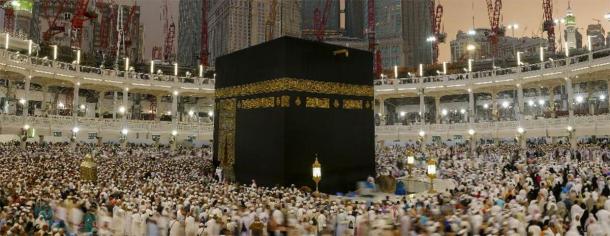
The Ka’aba, Mecca. (ETC )
Miracles at Mecca
According to Islamic belief, Abraham was instructed by God to bring Hagar and their son, Ishmael, to Arabia from Palestine to protect them from the jealousy of Sarah. Abraham brought the two of them to the site of Mecca, and left them there, as instructed by God. Although he gave them some supplies of food and water before leaving, it ran out.
Soon, Hagar and Ishmael were suffering from hunger and thirst. In desperation, the mother ran up and down two hills, Safa and Marwa, to see if she could spot any help in the distance. Finally, Hagar collapsed beside her son out of exhaustion, and prayed to God for help. At that moment, Ishmael struck his foot on the ground, and water gushed out, and thus the two were saved. This is said to be the origin of the Well of Zamzam. The Spring of Zamzam, from which the well draws its waters, is believed to be a tributary of the Waters of Paradise.
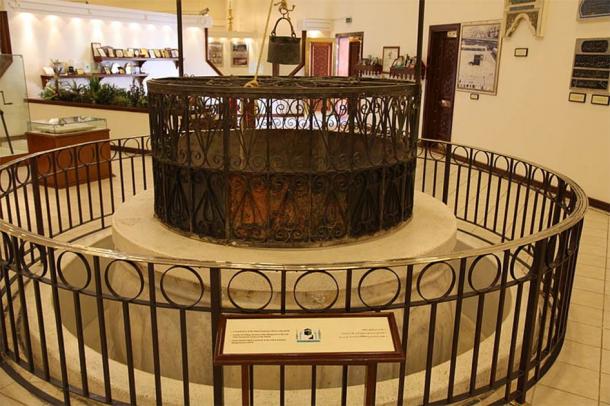
Historic Zamzam well mouthpiece. The description reads: (line 1) The mouthpiece of the well of Zamzam. (line 2) The pulley for lifting Zamzam water dating back to the end of the fourteenth century of Hijrah. (line 3) The brass bucket which was used to be in the well of Zamzam dating back to 1299 Hijrah. (Mohammad Bahareth/CC BY SA 2.0)
The miracle not only saved Hagar and Ishmael, but also allowed them to make a living, as they were able to trade their water with passing nomads for food and supplies. Sometime later, Abraham returned to check on Hagar and Ishmael, and was commanded by God to build the Ka’aba. According to one interpretation of the verse, Abraham was told to rebuild the shrine.
This may mean that there was an older shrine, one said to have been erected by Adam, the foundations of which were left by the time of Abraham. As time went by, the people of Mecca became polytheists, and idols were placed in the Ka’aba. When the Meccans surrendered to Muhammad in 630 AD, the Ka’aba was cleansed of its idols.
- The Life of the Prophet Muhammad: Spreading Islam from Mecca to Medina
- The Kaaba Black Stone: A Holy Stone from Outer Space?
- One of the Oldest Islamic Holy Sites in the World Discovered in Israel
The Meaning of the Ka’aba Black Stone at Mecca
In the eastern corner of the Ka’aba is the Black Stone. As part of the tawaf, pilgrims touch and kiss this sacred object. The Black Stone is believed to date to the time of Adam and Eve. According to Islamic belief, the stone was given to Adam when he was cast out of Paradise so that he could obtain forgiveness for his sins.
The Black Stone is said to have been concealed during the Great Flood, but was restored to Abraham when he was building / re-building the Ka’aba. Legend has it that the stone was originally white in color, but turned black as a result of absorbing the sins of the countless pilgrims who have touched and kissed it.
Mecca’s status as the holiest city in Islam has been maintained from the faith’s beginning till this day. In the almost 1400 years since Islam was established, Mecca has seen its fair share of ups and downs. Ownership of the sacred city, for instance, has switched hands many times in its long history.
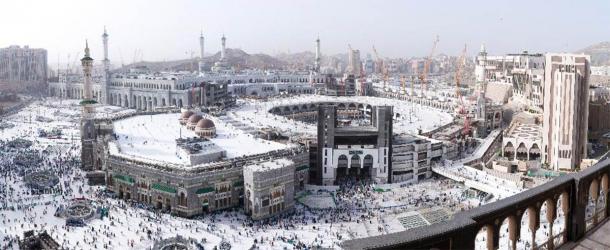
Wide panoramic view on entire Masjid Al Haram mosque from Clock Tower Abraj Al Bait, Mecca, Saudi Arabia. (Andrey Markelov /Adobe Stock)
In 1269, for example, Mecca came under the control of the Mamluks, while in 1517, the city fell into the hands of the Ottomans. In 1925, Mecca was captured by the Saudis, and it has remained a part of their kingdom since then. For the faithful, however, such political changes are of secondary importance, as the Hajj has been performed over the centuries, regardless of who is in charge of the city.
Top Image: Mecca, Saudi Arabia. Source: Haris Gunawan / Adobe Stock
By Wu Mingren
References
Glubb, J. B. & Abdo, A. S., 2019. Mecca. [Online]
Available at: https://www.britannica.com/place/Mecca
New World Encyclopedia, 2020. Mecca. [Online]
Available at: https://www.newworldencyclopedia.org/entry/Mecca
Razwy, S. A. A., 2020. Arabia before Islam. [Online]
Available at: https://www.al-islam.org/restatement-history-islam-and-muslims-sayyid-ali-ashgar-razwy/arabia-islam
Sacred Land Film Project, 2020. Mecca. [Online]
Available at: https://sacredland.org/mecca-saudi-arabia/#:~:text=Mecca%E2%80%94officially%20%E2%80%9CMakkah%E2%80%9D%E2%80%94,of%20Dhu'l%2DHijja.
Sinai, N. & Watt, W. M., 2020. Muhammad. [Online]
Available at: https://www.britannica.com/biography/Muhammad
The BBC, 2009. Hajj: pilgrimage to Mecca. [Online]
Available at: https://www.bbc.co.uk/religion/religions/islam/practices/hajj_1.shtml
The BBC, 2011. Prophet Muhammad (570-632). [Online]
Available at: https://www.bbc.co.uk/religion/religions/islam/history/muhammad_1.shtml
The Editors of Encyclopaedia Britannica, 2017. Hejaz. [Online]
Available at: https://www.britannica.com/place/Hejaz
The Editors of Encyclopaedia Britannica, 2019. Kaaba. [Online]
Available at: https://www.britannica.com/topic/Kaaba-shrine-Mecca-Saudi-Arabia
The Editors of Encyclopaedia Britannica, 2020. Hajj. [Online]
Available at: https://www.britannica.com/topic/hajj
The Editors of Encyclopaedia Britannica, 2020. Jāhiliyyah. [Online]
Available at: https://www.britannica.com/topic/jahiliyah
www.oxfordislamicstudies.com, 2020. Jahiliyyah. [Online]
Available at: http://www.oxfordislamicstudies.com/article/opr/t125/e1157


















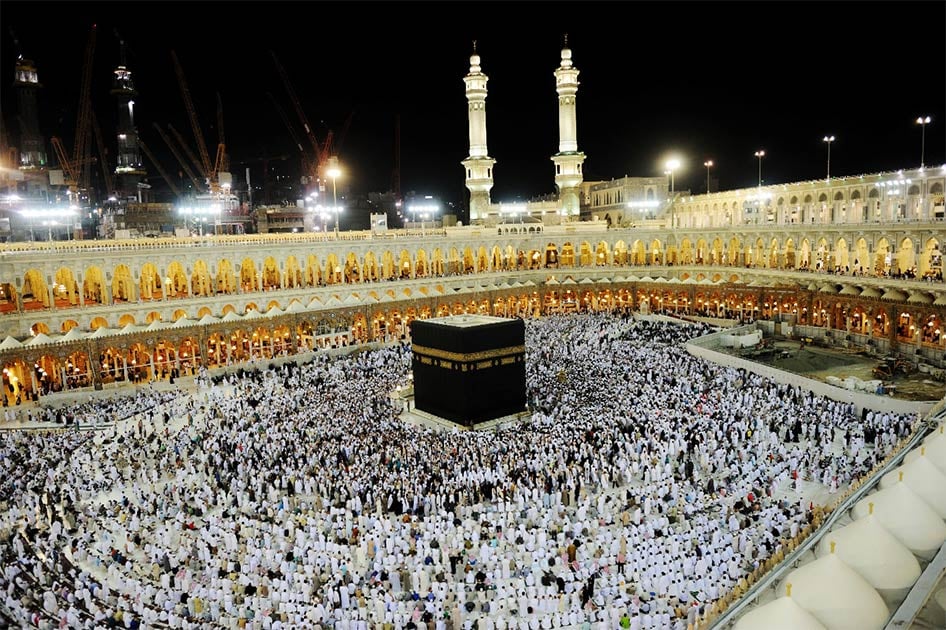

Comments
And now social media plays a role, allowing people to watch the clerics online as if they were really there and there is even an IT office nearby related to the mosque that offers religious guidance in all aspects of life that people ask.
Only Muslims are allowed into the city.